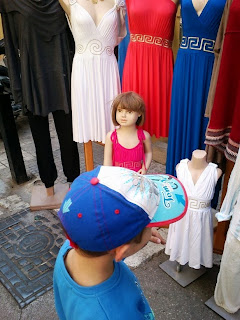 |
  |
My way of
selling the Plaka walk to the seven-year-old “I‘d-rather-stay-home” Odysseas,
was by presenting it as time travel –which was no big lie.
Walking Plaka’s
alleys, you come across the Ancient Roman Agora, a Turkish Medrese school,
Byzantine churches, red-roof early 1900’s neoclassic houses, the city’s first
University and what is commonly accepted as Athens
We rode the
time-capsule (Athens’ metro) and got off at Monastiraki, where a Nemo balloon
rose all the way to the station’s ceiling, as if to take a closer look at an
art installation titled “Time in my
Hands”. How very appropriate for all those embarking on time travel!
Outside the
station is a good place to buy fresh fruit and snacks from the street vendors
before turning right and walking up, past Hadrian’s Library and towards the
Roman Agora. It was not the back-to-the-Roman-era button that we wanted to push
though. Instead, we rewound to the years of the Ottoman rule and looked through
the bars of the gate surrounding Fethiye Mosque, a beautiful stone and brick
building consecutively used as a temple, prison, army bakery and storage area
for the Agora’s ancient finds.
Just around the corner, stands another unique
sample of Ottoman architecture: the big wooden door of the Medrese school. The door is about the only thing that remains of
the original building. A time travel facade!
So we turned our attention across the Medrese and several centuries back, to a very special monument of ancient mechanics: The Tower of the Winds. This octagonal marble tower served as a solar clock with a back-up hydraulic mechanism. On its top stood a wind vane, right below which personifications of six different types of winds are sculpted into the marble. The one who carries fruits in his arms was the one we liked best, and we nibbled our pears and bananas in his company.
  |
We then took a small detour to 2004 to have a mini sprint in the couloirs that were built during the Athens ’ Olympics in Lysiou street , before heading uphill, towards the building that served the city as its first University and is now a museum.
In remembrance of the canon shots that celebrated the University’s inauguration in 1837, were the nuts that bombarded us falling off the tree in its yard. Odysseas and Filippos used the nuts as artillery to aim at the door buzzer but the museum was closed on the day of our visit.
We had to
look carefully to find the next stop on our journey, hidden behind a tall white
wall. The church monastery of Panagios
Tafos (Holly Grave) is a mystic inner courtyard of tranquility. Below its
cells and well are said to be tunnels that lead to other underground spots
around the Acropolis.
But when we
visited, a christening was in process and we did not find someone available to
ask. The boys chased pretty girls in pink around the citrus trees and we flew
off before their parents had enough time to tell us off.
The final stop in our journey went with a story that has a special appeal to kids. It’s the story of the Benizelos family home, Athens ’ oldest house -built in the 16th century. Approach its main entrance on Adrianou street and you will see nothing but a blue door and a tall wall that served protect family life in rough times. Walk around the wall to its back side, and you will see the recently restored mansion in full glory.
And the story that makes this house special is that the girl who inhabited it, died a saint. Rigoula Benizelou married at 16, became a widow at 19, raised her three children on her own, built schools and monasteries to help and protect 200 girls from the Turks who dominated Athens at that time and died a saint –Saint Filothei.
My two little anything-but-saints called for yogurt ice-cream at one of the shops along Kidathineon street and laughed with the ancient Greek style dresses for kids, tsarouxi shoes and other equally entertaining souvenirs made in kitschland.
  |
Odysseas vetoed a visit to the hands-on Children’s Museum nearby, but I would definitely recommend it as a pleasant and meaningful stop when visiting Plaka with kids.
Walking towards Syntagma metro station, we crossed Tom’s Irish Republic
  |
 |
We silently crammed into a train full of people heading home for lunch and a gentleman from Pakistan kindly offered us his seat. Odysseas and Filippos squeezed in and collapsed, tired from our time travels.
And then, they put their arms around each other and cuddled. I smiled and wondered if it was just the lack of space or that warmer inner feeling shared by fellow travelers.
 |
| Time in my Hands! |















